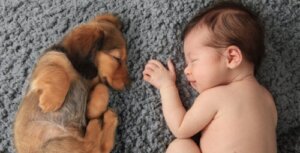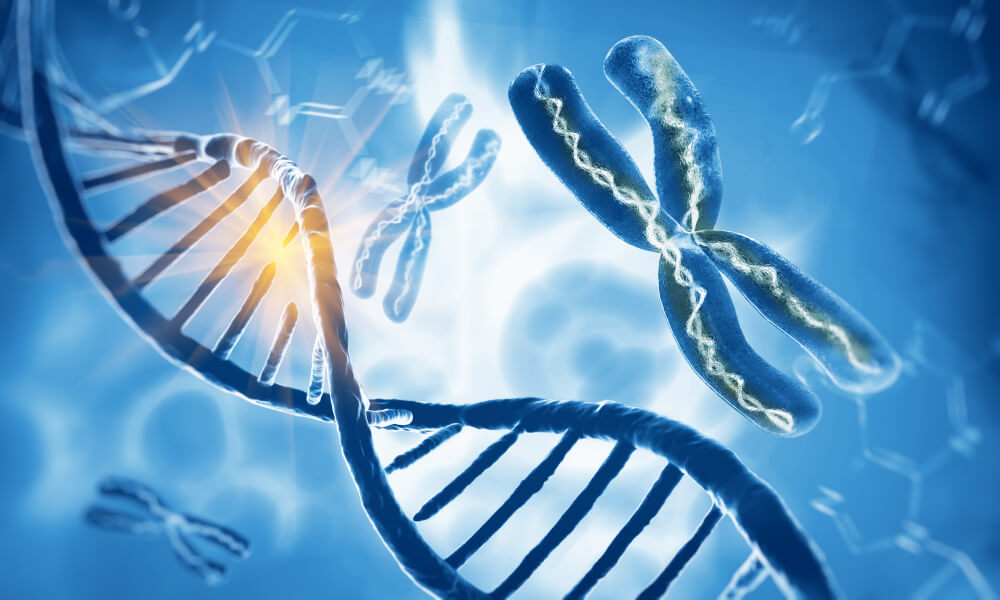Can a Baby's Hair Color Change?

One of the big questions for expectant parents is whether the color of their baby’s hair can change. While there are many characteristics that tend to change over time, science isn’t very conclusive about hair color.
However, experience has shown that a baby’s hair color varies during the first year of life. Here, we’ll tell you more about this.
When is a baby’s hair color determined?
At the moment of conception, the sperm comes into contact with the egg, and from this union, the egg or zygote is formed. Each parent offers its genetic information to the new being through chromosomes. Therefore, all the features of the future baby (eye color, sex, hair color, among others) are defined at this early stage.
Each cell of the embryo has 46 chromosomes: 23 from the father and 23 from the mother. However, the traits or characteristics depend on the genetic combination of the chromosomes in pairs, and the result is unique. For this reason, within the same family, some children often look more like one parent than the other or look like a mixture of both.

The interaction of the genes involved
Mendel’s laws are a set of rules that explain how the genetic transmission of physical traits occurs through the generations. According to these laws, a baby’s hair color depends on the combination of genes from both parents.
In turn, each gene in the baby is made up of different alleles. In the case of hair color, in general, dominant alleles are associated with dark hair and recessive alleles are associated with light shades. That’s to say, a child only needs to have one parent with dark hair in order to have this shade, and two parents with light hair are required for the baby to inherit this color. Despite theory, this isn’t always the case.
Finally, some genes are expressed in response to certain hormones, so in some cases, the final hair color may not become apparent until adolescence.
While science has tried to explain how children’s hair color is determined, according to a publication by the Tech Museum of Innovation, there’s still much research to be done.
Read also: How to Cut Your Baby’s Hair?
The pigments that determine hair color
The type and amount of pigment in infants’ hair, along with their distribution, help define the overall shade of hair. It should be noted that these characteristics can evolve over time, just as they do in newborns.
There are two hair pigments in humans:
- Eumelanin, which determines brown/black colors.
- Pheomelanin, which is responsible for red and blond tones.
The combination of both pigments results in the natural, final hair color.
You might be interested in: How to Wash Your Baby’s Hair and How Often
Why does a baby’s hair color change?
The color change process in babies is known as physiological hair shedding.
Newborn hair falls out spontaneously during the first few months of life to make room for the development and growth of new hair.
Although prenatal hair sometimes has the same pigmentation as the final hair, sometimes the new hair has different coloring than the old hair.
The cells responsible for providing color are melanocytes that produce melanin, a natural pigment that colors the cells of the iris of the eye and the skin. The melanocytes that the baby has are immature and over time, they increase their functionality and color production.

The final hair color
It’s not so simple to guess what a baby’s hair color will be in the future. Like other physical traits, the appearance of the hair is determined by the baby’s DNA sequence. That is, by the combination of genes inherited from mom and dad.
However, it’ll take some time to develop the final shade, as this isn’t the only determining factor. It’s worth considering the color of the eyelashes and eyebrows to get an idea of what the final look of the rest of the hair will be.
Baby hair color and its changes
In conclusion, a baby’s hair color changes shades several times after birth before reaching the final color. It’s only by the second birthday that the future appearance and color may be determined, which will be with the baby for the rest of their life.
One of the big questions for expectant parents is whether the color of their baby’s hair can change. While there are many characteristics that tend to change over time, science isn’t very conclusive about hair color.
However, experience has shown that a baby’s hair color varies during the first year of life. Here, we’ll tell you more about this.
When is a baby’s hair color determined?
At the moment of conception, the sperm comes into contact with the egg, and from this union, the egg or zygote is formed. Each parent offers its genetic information to the new being through chromosomes. Therefore, all the features of the future baby (eye color, sex, hair color, among others) are defined at this early stage.
Each cell of the embryo has 46 chromosomes: 23 from the father and 23 from the mother. However, the traits or characteristics depend on the genetic combination of the chromosomes in pairs, and the result is unique. For this reason, within the same family, some children often look more like one parent than the other or look like a mixture of both.

The interaction of the genes involved
Mendel’s laws are a set of rules that explain how the genetic transmission of physical traits occurs through the generations. According to these laws, a baby’s hair color depends on the combination of genes from both parents.
In turn, each gene in the baby is made up of different alleles. In the case of hair color, in general, dominant alleles are associated with dark hair and recessive alleles are associated with light shades. That’s to say, a child only needs to have one parent with dark hair in order to have this shade, and two parents with light hair are required for the baby to inherit this color. Despite theory, this isn’t always the case.
Finally, some genes are expressed in response to certain hormones, so in some cases, the final hair color may not become apparent until adolescence.
While science has tried to explain how children’s hair color is determined, according to a publication by the Tech Museum of Innovation, there’s still much research to be done.
Read also: How to Cut Your Baby’s Hair?
The pigments that determine hair color
The type and amount of pigment in infants’ hair, along with their distribution, help define the overall shade of hair. It should be noted that these characteristics can evolve over time, just as they do in newborns.
There are two hair pigments in humans:
- Eumelanin, which determines brown/black colors.
- Pheomelanin, which is responsible for red and blond tones.
The combination of both pigments results in the natural, final hair color.
You might be interested in: How to Wash Your Baby’s Hair and How Often
Why does a baby’s hair color change?
The color change process in babies is known as physiological hair shedding.
Newborn hair falls out spontaneously during the first few months of life to make room for the development and growth of new hair.
Although prenatal hair sometimes has the same pigmentation as the final hair, sometimes the new hair has different coloring than the old hair.
The cells responsible for providing color are melanocytes that produce melanin, a natural pigment that colors the cells of the iris of the eye and the skin. The melanocytes that the baby has are immature and over time, they increase their functionality and color production.

The final hair color
It’s not so simple to guess what a baby’s hair color will be in the future. Like other physical traits, the appearance of the hair is determined by the baby’s DNA sequence. That is, by the combination of genes inherited from mom and dad.
However, it’ll take some time to develop the final shade, as this isn’t the only determining factor. It’s worth considering the color of the eyelashes and eyebrows to get an idea of what the final look of the rest of the hair will be.
Baby hair color and its changes
In conclusion, a baby’s hair color changes shades several times after birth before reaching the final color. It’s only by the second birthday that the future appearance and color may be determined, which will be with the baby for the rest of their life.
All cited sources were thoroughly reviewed by our team to ensure their quality, reliability, currency, and validity. The bibliography of this article was considered reliable and of academic or scientific accuracy.
- Can you tell me more about the genetics of hail color. [Internet] Disponible en: https://www.thetech.org/ask-a-geneticist/ask39
- Neri I, Piccolo V, Cocchi G, Starace M, Patrizi A, Dika E, Piraccini BM. Hair in newborns and infants: clinical and dermoscopic evaluation of 45 cases. Br J Dermatol. 2013 Oct;169(4):896-900. doi: 10.1111/bjd.12459. PMID: 23746094.
- Lewis RG, Simpson B. Genetics, Autosomal Dominant. 2021 May 7. In: StatPearls [Internet]. Treasure Island (FL): StatPearls Publishing; 2022 Jan–. PMID: 32491444.
This text is provided for informational purposes only and does not replace consultation with a professional. If in doubt, consult your specialist.








